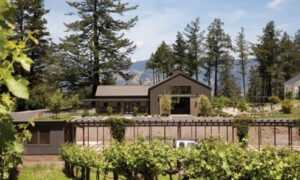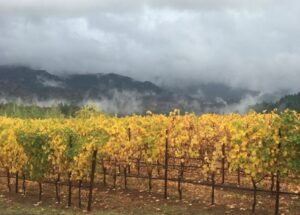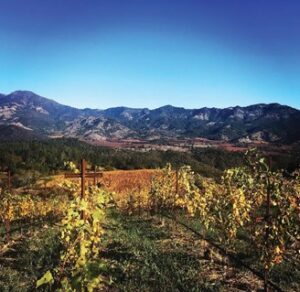Napa Varietal Series + SIP
Diamond Mountain District AVA
Published On: April 08, 2021

Diminutive Yet Dynamic
Rising above Calistoga, the steep and rocky Diamond Mountain District AVA draws vintners who desire the vital characteristics that make a Diamond Mountain wine: intensity, concentration, and ageability. “Several notable vintners and winemakers have specifically sought out Diamond Mountain as their winery home,” said Dawnine Dyer, who, with husband Bill, owns Dyer Wine on 2.5 acres within the AVA, where they produce Cabernet Sauvignon and Cabernet Franc. “Cab Franc does beautifully in our soils. It’s very distinct with consistent flavor. Diamond Mountain District wines feature great tannin structure, not big red fruit, like raspberry or blackberry, but lovely blue fruit characters, plum, currant, cherry, fruit flavors with wonderful structure and minerality.”
At just 600 acres, the northernmost AVA in the Mayacamas Mountains is home to fewer than 20 wineries. Petrified Forest Road defines its boundaries to the north, the Spring Mountain District to the south, the Napa/Sonoma County line to the west, and Highway 29 to the east.

“One of the defining features of the Diamond Mountain District is its many small producers making wines from small plots of land,” said Dyer, one of the forces behind the region’s formal 1999 AVA designation. “Each unique interpretation of their specific terroir is exciting.”
Dyer and her husband know of what they speak and of what they make. She spent 25 years producing sparkling wines at Chandon, while he served as winemaker at Sterling Vineyards for 20 years. Dyer Wine is their personal project. “Though small, this region easily justifies its AVA designation,” said Dyer. “The soils are volcanic across the region – well-drained and mineral-rich. The AVA sits between 400 ft and 2000 ft. and benefits from being removed from the valley floor- less extreme heat and effectively frost-free. While there are many different exposures, our vineyard is north west facing and slopes down towards the Valley floor to rocky, reddish, and porous soils.”
Named for the volcanic glass and obsidian that sparkles within those soils, Diamond Mountain and its history can be traced to the 19th century when settlers first arrived in the area. The region’s first vines were planted by Jacob Schram (Schramsberg Vineyards) in the early 1860’s. Today, the AVA attracts top winemaking talent at wineries such as Dyer, Wallis Family Estate, The Vineyardist, Vineyard 511, Theorem, Castello di Amorosa, Diamond Creek, Checkerboard, and Constant Diamond Mountain. Wineries that make wine utilizing Diamond Mountain vineyard fruit include Cardinale, Sterling, Hall, and von Strasser.

“Without hesitation, the area’s settlers cleared trees, built homes for their families, and began farming the extremely rocky and iron-rich volcanic soil,” said Kathleen Ward, assistant winemaker at Theorem Vineyards, located within the northernmost portion of the AVA. “Those original pioneers laid the foundation for what would become a world- class winemaking region. I am amazed by the courage and hard work it must have taken to tame this wild and unknown land back then. To this day, there are only a few wineries on Diamond Mountain, relative to other mountainous AVAs, a reflection of the rugged terrain here and the fierce determination of those early settlers.”
“What I love about wines produced from the Diamond Mountain District AVA is that they possess the perfect balance between ripeness and freshness,” said Ward. “The daytime temperatures on the mountain are reliably warm, helping to develop great flavor and fruit concentration. However, each afternoon, like clockwork, breezes from the coast arrive at 3 pm and begin cooling everything down. This unique climate helps preserve grape acidity, producing wines that have signature ‘mountain fruit’ tannin structure and a long, satisfying finish that keeps you coming back for another sip.”

When Dirk Fulton and his wife Becky Kukkola sought property in 1990 to establish their winery The Vineyardist, they gathered a top-notch team of experts, including cult winemaker Mark Herold, and initiated their search on Diamond Mountain. Fulton and Kukkola had long been fans of wines produced in the region. They felt lucky to find a historic property on which vineyards initially had been planted in the 1870s. They liked the exposures and were able to create unobstructed vineyard blocks. They have been farming their 120 acres, 24 of which are planted to vine, since 2000; Herold served as founding winemaker for 12 years until Tony Biagi took the reins.
“We kicked a lot of tires throughout the Valley, but we kept coming back to Diamond Mountain,” said Fulton, whose The Vineyardist wines routinely score in the high 90s. “We thought of the area as the new Pritchard Hill; the region was enjoying a renaissance, and we wanted to be part of it. Diamond Mountain’s microclimates, the exposures, the terroir, the steep hillsides, and the soil’s volcanic nature make the vines struggle a bit, resulting in tiny berries with concentrated flavors. We love the somewhat untamed nature of the region. It’s wild up here; there is truly something special going on. Our goal was to find a place at which our team of experts over time could produce world-class Cabernet Sauvignon. With the right people, the right plan, a daily commitment to the pursuit of perfection and this amazing terroir, we found that place here on Diamond Mountain.”
Article By: Fran Miller
